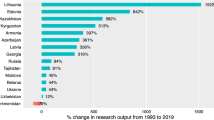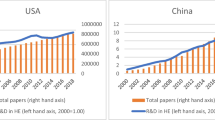Abstract
This study aims to undertake a bibliometric investigation of the NASA Astrobiology Institute (NAI) funded research that was published between 2008 and 2012 (by teams of Cooperative Agreement Notice Four and Five). For this purpose, the study creates an inventory of publications co-authored through NAI funding and investigates journal preferences, international and institutional collaboration, and citation behaviors of researchers to reach a better understanding of interdisciplinary and collaborative astrobiology research funded by the NAI. Using the NAI annual reports, 1210 peer-reviewed publications are analyzed. The following conclusions are drawn: (1) NAI researchers prefer publishing in high-impact multidisciplinary journals. (2) Astronomy and astrophysics are the most preferred categories to publish based on Web of Science subject categories. (3) NAI is indeed a virtual institution; researchers collaborate with other researchers outside their organization and in some cases outside the U.S. (4) There are prominent scholars in the NAI co-author network but none of them dominates astrobiology.







Similar content being viewed by others
Notes
Teams are named after the principal investigator’s institution; however, this naming is misleading because these teams are in fact a consortium of researchers from different institutions which create distributed networks. For instance, the Pennsylvania State University Team has researchers affiliated with 40 other institutions in addition to the Pennsylvania State University (41 institutions in total) or the Virtual Planetary Laboratory at the University of Washington Team members are affiliated with 25 institutions all over the world. In addition, a researcher can contribute to more than one team.
The reason for using journal category is the assumption that certain journals have certain audiences based on their category. Publishing in a different category means reaching out to a different audience, hence a proxy for multidisciplinary interaction.
In this section “Astronomy & Astrophysics” is the Web of Science Subject Category—not the journal title.
Betweenness centrality is a more useful measure (than just connectivity) both the load and importance of a node. The former is more global to the network, whereas the latter is only a local effect. The thickness of the lines (edge) shows the degree of connection between the two nodes. The size of the node is the frequency of publications in that domain. The color of the line is the year of publication. Pink Circle means that that node is pivot node—that is the node that makes the interdisciplinary connection. These nodes are strategically important in pulling other nodes together; they have the highest betweenness centrality which is an indicator of a node’s ability to make connections to other nodes in a network (Chen et al. 2008, p. 238).
Here astro-, geo-, and bio- sciences are used in the broadest, most general sense.
References
AIRFrame. (2014). Astrobiology integrative research framework project. http://airframe.ics.hawaii.edu/. Accessed January 28, 2014.
Al, U., Taşkın, Z., & Düzyol, G. (2012). Use of social network analysis in bibliometric researches. BOBCATSSS 2012. In Information on E-motion (pp. 40–44). BOBCATSSS 2012, Amsterdam, January 23–25, 2012.
Benner, S. A., Bains, W., & Seager, S. (2013). Models and standards of proff in cross-disciplinary science: The case of arsenic DNA. Astrobiology, 13, 510–513.
Blumberg, B. (2003). The NASA Astrobiology Institute: Early history and organization. Astrobiology, 3, 463–470.
Boyack, K. W., Klavans, R., & Börner, K. (2005). Mapping the backbone of science. Scientometrics, 64(3), 351–374.
Brazelton, W. J., & Sullivan, W. T. (2009). Understanding the nineteenth century origins of disciplines: Lessons for astrobiology today? International Journal of Astrobiology, 8, 257–266.
Carpenter, M., Bauer, T., & Erdogan, B. (2009). Principles of management. Washington: Flat World Knowledge.
Chen, C. (2006). CiteSpace II: Detecting and visualizing emerging trends and transient patterns in scientific literature. Journal of the American Society for Information Science and Technology, 57, 359–377.
Chen, C. (2014a). CiteSpace: Visualizing patterns and trends in scientific literature. http://cluster.cis.drexel.edu/~cchen/citespace/. Accessed December 22, 2014.
Chen, C. (2014b). The CiteSpace manual. http://cluster.ischool.drexel.edu/~cchen/citespace/CiteSpaceManual.pdf. Accessed December 22, 2014.
Chen, C., Song, I.-Y., Yuan, X., & Zhang, J. (2008). The thematic and citation landscape of data and knowledge engineering (1985–2007). Data & Knowledge Engineering, 67, 234–259.
Des Marais, D., Nuth, J. A., Allamandola, L. J., Boss, A. P., Farmer, J. D., Hoehler, T. M., et al. (2008). The NASA astrobiology roadmap. Astrobiology, 8(4), 715–730.
Gowanlock, M., & Gazan, R. (2013). Assessing researcher interdisciplinarity: A case study of the University of Hawaii NASA Astrobiology Institute. Scientometrics, 94, 133–161.
Hall, K. L., Stokols, D., Stipelman, B. A., Vogel, A., Feng, A., Masimore, B., et al. (2012). Does team science add value? A bibliometric study comparing the productivity of NIH-funded team science center grants with single investigator driven grants. American Journal of Preventive Medicine, 42(2), 157–163.
Hanneman, R. A., & Riddle, M. (2005). Introduction to social network methods. Riverside, CA: University of California.
Katz, J. S., & Hicks, D. (1995). The classification of interdisciplinary journals: A new approach. In M. E. D. Koenig & A. Bookstein (Eds.), Proceedings of the fifth biennial conference of the International Society for Scientometrics and Informetrics (pp. 245–254). Medford: Learned Information.
Klavans, R., & Boyack, K. W. (2006). Quantitative evaluation of large maps of science. Scientometrics, 68(3), 475–499.
Lancaster, F. W., & Lee, J. L. (1985). Bibliometric techniques applied to issues management: A case study. Journal of the American Society for Information Science, 36, 389–397.
Miller, L. J., Gazan, R., & Still, S. (2014). Unsupervised document classification and visualization of unstructured text for the support of interdisciplinary collaboration. In Proceedings of the 17th ACM conference on computer supported cooperative work & social computing (CSCW 2014) (pp. 1033–1042). 15–19 February, Baltimore, MD.
Moravcsik, M. J., & ve Murugesan, P. (1975). Some results on the function and quality of citations. Social Studies of Science, 5, 86–92.
Morillo, F., Bordons, M., & Gómez, I. (2003). Interdisciplinarity in science: A tentative typology of disciplines and research areas. Journal of the American Society for Information Science and Technology, 54(13), 1237–1249.
NAI. (2014). International partners. https://astrobiology.nasa.gov/nai/international-partners/. Accessed 16 March 2015.
NASA Astrobiology Institute Website. (2013a). https://astrobiology.nasa.gov/nai/about/. Accessed February 1, 2014.
NASA Astrobiology Institute Website. (2013b). https://astrobiology.nasa.gov/nai/reports/annual-reports/. Accessed April 23, 2014.
National Research Council. (2004). Facilitating interdisciplinary research. Washington, DC: The National Academies Press.
National Research Council. (2008). Assessment of the NASA Astrobiology Institute. Washington, DC: The National Academies Press.
Oppenheim, C. (1996). Do citations count? Citation indexing and the research assessment exercise (RAE). Serials, 9(2), 155–161.
Porter, A. L., Cohen, A. S., Roessner, J. D., & Perreault, M. (2007). Measuring researcher interdisciplinarity. Scientometrics, 72(1), 117–147.
Porter, A. L., & Rafols, I. (2009). Is science becoming more interdisciplinary? Measuring and mapping six research fields over time. Scientometrics, 81(3), 719–745.
Rafols, I., Porter, A. L., & Leydesdorff, L. (2010). Science overlay maps: A new tool for research policy and library management. Journal of the American Society for Information Science and Technology, 61, 1871–1887.
Slonim, N., Friedman, N., & Tishby, N. (2002). Unsupervised document classification using sequential information maximization. In Proceedings of the 25th annual international ACM SIGIR conference on research and development in information retrieval (pp. 129–136). New York, USA.
Small, H. (1999). Visualizing science by citation mapping. Journal of the American Society for Information Science, 50(9), 799–813.
Stokols, D., Hall, K. L., Taylor, B. K., & Moser, R. P. (2008). The science of team science: Overview of the field and introduction to the supplement. American Journal of Preventive Medicine, 35(2), 77–89.
Thomson Reuters. (2014). Journal citation reports. http://wokinfo.com/products_tools/analytical/jcr/. Accessed April 12, 2014.
van Eck, N. J., & Waltman, L. (2010). Software survey: VOSviewer, a computer program for bibliometric mapping. Scientometrics, 84, 523–538.
van Eck, N. J., & Waltman, L. (2013). VOSviewer manual. http://www.vosviewer.com/documentation/Manual_VOSviewer_1.5.4.pdf. Accessed December 22, 2014.
VosViewer. (2013). http://www.vosviewer.com/. Accessed December 22, 2014.
Wagner, C. S., Roessner, J. D., Bobb, K., Klein, J. T., Boyack, J. W., Keyton, J., et al. (2011). Approaches to understanding and measuring interdisciplinary scientific research (IDR): A review of the literature. Journal of Informetrics, 165, 14–26.
Williams, C. J., O’Rourke, M., Eigenbrode, S. D., O’Loughlin, I., & Crowley, S. (2013). Using bibliometrics to support the facilitation of cross-disciplinary communication. Journal of the American Society for Information Science and Technology, 64(9), 1768–1779.
Wolfe-Simon, F., Blum, J. S., Kulp, T. R., Gordon, G. W., Hoeft, S. H., Pett-Ridge, J., et al. (2010). A bacterium that can grow by using arsenic instead of phosphorus. Science, 332, 1163–1166.
Wuchty, S., Jones, B. F., & Uzzi, B. (2007). The increasing dominance of teams in production of knowledge. Science, 316, 1036–1039.
Acknowledgments
This study was supported by the NASA Astrobiology Institute. In addition, we would like to thank to Thomson Reuters for making their relevant bibliometric datasets available to us.
Author information
Authors and Affiliations
Corresponding author
Rights and permissions
About this article
Cite this article
Taşkın, Z., Aydinoglu, A.U. Collaborative interdisciplinary astrobiology research: a bibliometric study of the NASA Astrobiology Institute. Scientometrics 103, 1003–1022 (2015). https://doi.org/10.1007/s11192-015-1576-8
Received:
Published:
Issue Date:
DOI: https://doi.org/10.1007/s11192-015-1576-8




